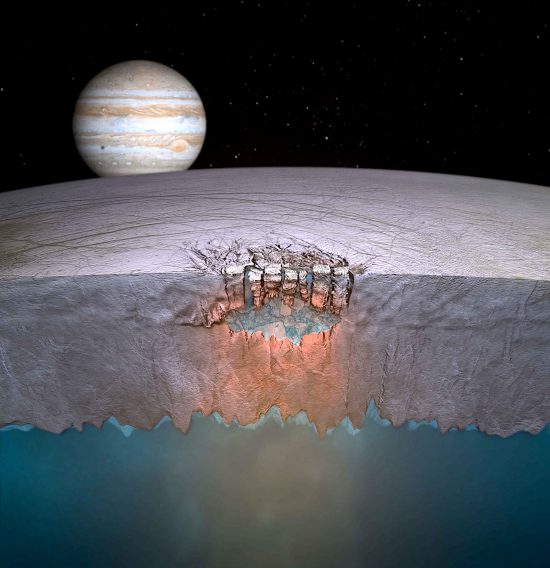
April 22, 2020
“So cold that if the thermometer had been an inch longer we’d all have frozen to death.”
— Samuel Clemens
The Galileo spacecraft was launched on October 18, 1989 from the Space Shuttle Atlantis, entering orbit around Jupiter on December 7, 1995. After eight years in orbit, Galileo was deliberately incinerated by sending into the atmosphere of Jupiter on September 21, 2003. This was done to prevent any materials from its body accidentally contaminating Jupiter’s moons, especially Europa.
Europa is extremely cold, with a mean temperature of −160 Celsius at the equator and −220 Celsius in its polar latitudes. At that temperature, water ice has a tensile strength equivalent to tempered steel on Earth.
Planetary scientists speculate that Europa might harbor some kind of life, even though it is so cold. They believe that beneath the ice-rock crust, the moon could have a “warm ocean”. Why would there be warmth in one of the coldest places in the Solar System?
Conventional interpretations suggest that Europa’s heat comes from “tidal kneading”: Jupiter’s gravity is supposed to stretch and compress the moon, creating so much internal friction that small pockets of liquid water form beneath the surface. It is in that “warm” ocean that life is thought to exist.
What is “life”? Life is said to move, grow, consume, require oxygen, give off waste and die. With this definition, fire can be thought of as life. In a stricter sense, life requires liquid water and a temperature range in which complex organic chemistry can take place. In order for life to exist on Europa, it must be able to fulfill those conditions, and more. Life is considered to be an emergent process, rather than a state of being, so its definition will never be clear cut.
As written previously, Europa’s surface is a multi-kilometer deep shell of water ice floating on a salty sea. The “decoupled” surface undergoes periodic deformation, because ice movement creates stress cracks, allowing gigantic rafts to form. However, Galileo’s high resolution camera revealed smoothly cut channels that do not look like fractures. Their orientation disregards prior channels, sometimes with five or six of them stacked on top of each other at every angle. As electrical experiments in Dr. C. J. Ransom’s Vemasat Laboratories reveal, this should come as no surprise. Electric currents flowing across a conductive surface are “pinched” into thin filaments by their associated magnetic fields and draw other filaments into parallel alignment. The trackways often overlap each other.
When electric arcs strike a sphere, smaller, perpendicular side channels are created by corona discharges. Darkened, scorched areas, pits, curving channels that appear to be centered on Europa’s poles, and a lack of craters are all duplicated in Vemasat experiments. NASA’s surprises are expected by Electric Universe advocates because plasma behavior scales by many orders of magnitude. From the laboratory to the Solar System’s planets and moons, plasma is the primary ingredient that shapes worlds, not kinetic squeezing and stretching. There is most likely no subsurface ocean on Europa, and the chaotic terrain does not result from interior processes.
Stephen Smith
The Thunderbolts Picture of the Day is generously supported by the Mainwaring Archive Foundation.












